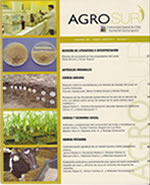Respiration and microbial biomass quantification in Southern Colombia Andisols
Main Article Content
Abstract
Soil respiration was evaluated by quantifying CO2 and carbon from microbial biomass (CBM) in a livestock production system that integrates different land uses, located south-east of the municipality of Pasto. The evaluated uses correspond to secondary forest, prairie and silvopastoral system (Ssp), at two depths (0-10 cm and 10-20 cm). A completely randomised design was used in a 3x2 factorial arrangement (Factor A: uses, Factor B: depths). The soils presented a sandy loam texture, moderately acidic pH, high cation exchange capacity, high organic carbon content, medium calcium, magnesium and potassium content, and low phosphorus content. The classification analysis allowed the formation of three groups that coincided with the three land uses evaluated, where the Ssp presented the highest number of variables above the general average of the study. The Anova showed a p-value <0.001 for the interaction use * depth; Tukey’s means comparison tests allowed establishing that the highest respiration values occurred in the forest at a depth of 0-10 cm (1.89 mg-1 CO2 C g-1 soil-1), while in the Ssp at a 10-20 cm depth the lowest respiration values occurred (0.072 mg-1 CO2 C g-1 soil-1). The CBM presented higher values in the forest at a depth of 0-10 cm (179.19 μg-1C g-1 soil-1) and lower values in the Ssp at a depth of 0-10cm (117.72 μg-1C g-1 soil-1).

